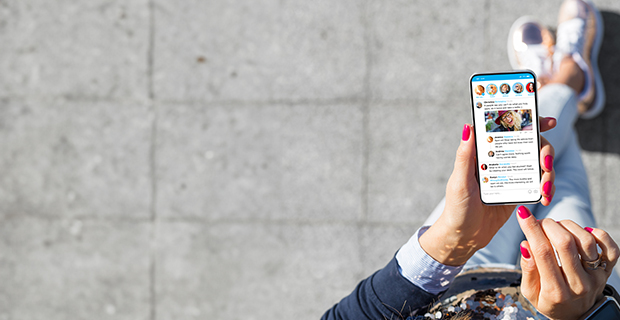Boosted vs Promoted Posts: How to Extend Your Social Reach


Published on: October 19, 2023
When it comes to extending your reach on social media, you have two options: boost or promote. Boosting a post is the quickest and most convenient way to gain additional eyes on organic content, while paid advertising gives you advanced targeting options for greater control and customization. So, how do you choose? Here's a breakdown of each strategy to help you determine which makes the most sense for your business.
Choosing the right strategy
When deciding whether to boost or promote social media posts, businesses should consider their specific goals and budget. Boosting is a suitable option for businesses seeking quick visibility and targeting a broader audience. It's a convenient and straightforward approach that requires minimal setup and can be done directly on the platform. On the other hand, promoting posts provides more advanced customization options and precise targeting criteria. This strategy is ideal for businesses with specific marketing objectives, such as lead generation or driving conversions.
To make an informed decision, businesses should assess their budget and determine the level of control and customization they require. Boosting is typically more cost-effective for smaller campaigns, while promoting may require a larger budget for optimization and advanced targeting features. By aligning their goals, budget, and desired level of customization, businesses can choose between boosting and promoting to effectively amplify their social media presence.
Here's a quick rundown on the pros and cons when considering boosting vs. promoting social posts:
Boosting
Pros:
Cons:
Promoting (paid ads)
Pros:
Cons:
Does the platform make a difference?
When deciding between boosting and promoting social media posts, businesses should also consider platform-specific factors. Each social media platform offers different features and targeting capabilities that may influence the choice between boosting and promoting. For example, Facebook's boosting option allows businesses to easily reach a wider audience, while its promotion tools provide more advanced targeting options and campaign optimization. Instagram, on the other hand, offers similar boosting and promoting functionalities, but with a focus on visual content and influencer marketing. Twitter's promotion options excel in real-time engagement and driving conversations around a post. By understanding the unique strengths and features of each platform, businesses can choose the most suitable approach to achieve their marketing goals and effectively reach their target audience.
Facebook posts tend to get better engagement than advertising, and you can find rates as low as $1/day. For only slightly higher investments, boosted posts can get significantly more traffic. You likely need to be comfortable with Facebook Ads Manager to run an ad campaign on Facebook, making it a more time-intensive option.
You need a business account to advertise on Instagram, but once that's done, it becomes fairly simple. You can craft an ad on your dashboard from scratch or link to an existing post to boost it. There's a review period after submitting your post, but after it's approved, you have great insight tools to track the effectiveness of each post.
X (formerly Twitter)
X has a Quick Promote feature that lets you promote a post from your timeline. You might have seen a prompt after an ordinary tweet asking if you'd like to consider boosting what you just sent out. If you click on this, you’ll find that X has an expansive suite of tools for honing your target audience and fine-tuning throughout the length of the promotion.
LinkedIn is generally an ad-friendly platform for several reasons. It caters to a more professional public and the site design is accommodating for plain ads that don't have to fight too hard for attention on a cluttered feed. The site has a dedicated page for ads where you can promote a native post to target audiences defined by their industry, seniority level, job function, and experience level.
TikTok
TikTok caters to a younger crowd, but the ad program comes equipped with pre-designed ad templates and easy video editing tools. The platform offers smart audience targeting and decent customer support, which leans toward a more paid-ad-centered approach than a simple boost.
Which is better?
Targeted social media ads can be complex, but several platforms go out of their way to give you the tools to succeed. The choice to boost a post or craft a new ad is ultimately a judgment call, and your decisions could easily change as your goals and budgets shift, as your team’s skills develop, and as the needs of your audience change throughout the campaign.
Conclusion
Understanding the unique features and capabilities of each social media platform allows businesses to leverage their strengths and reach their target audience more effectively. Ultimately, by weighing these considerations, businesses can harness the power of social media to amplify their brand, engage with their audience, and achieve their marketing objectives. Still haven’t taken the leap to put your business on social media? Find out why engaging on these platforms could be an untapped avenue for driving conversions here.
Explore the latest B2B topics and gain insight to adapt best practices for success and help grow your business.
There’s a certain romance to the idea of evergreen content. Publish once, watch it climb search rankings, and let it generate traffic indefinitely...
MoreAnyone producing content today has seen how quickly trust evaporates the moment an educational piece turns into a sales ambush. A guide starts...
MoreIn a world that often underestimates what people with disabilities can achieve, Vibrant Works is flipping the narrative — one job, one product, one...
MoreComplete the form below and we’ll get in touch with you right away.
You are now in accessibility mode. To restore settings to default, click the accessibility icon on the right hand side.